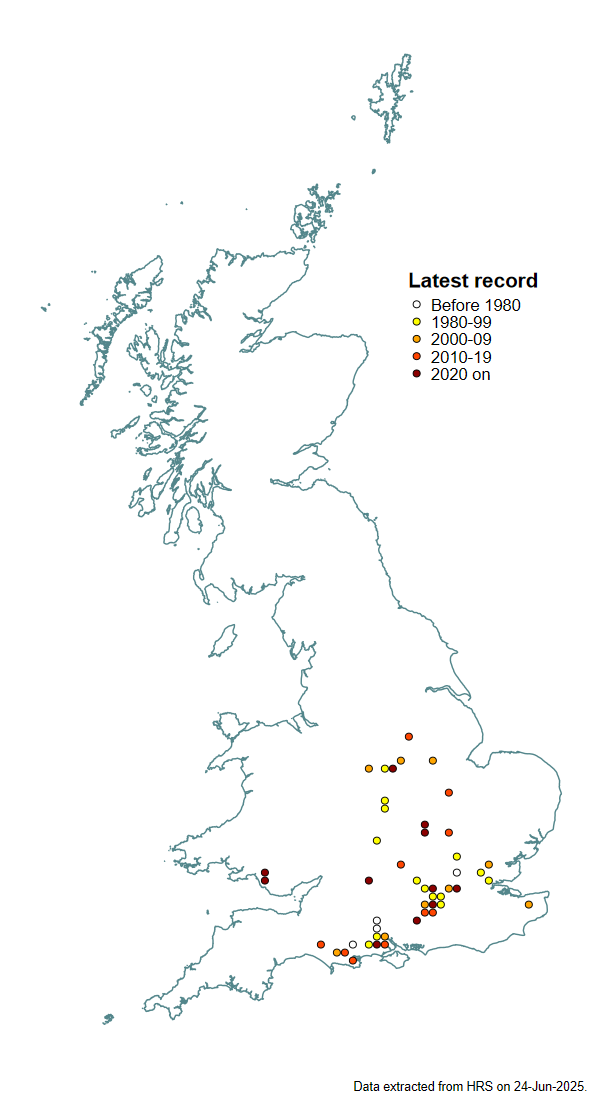Psilota anthracina Meigen, 1822
Identification
Identification difficulty = 3. ![]()
![]() according to Ball & Morris, 20241
according to Ball & Morris, 20241
Synonymy
There are recent continental additions to this genus and five species are now recognised in Europe (Speight, 2017)2, although British specimens have been checked and confirmed to be P. anthracina.
Biology
On the continent, the larva has been found in sap runs on trees (Kassebeer, et al. 19983; Stubbs, 19964). Speight (2017)2 suggests that larvae and puparia described by Kassebeer may have been either (or both) P. anthracina and/or P. atra, but larvae from accumulations of decaying sap under Spruce Picea bark are presumably those of P. anthracina. In Britain, it is restricted to sites with large numbers of ancient trees. Adults are elusive, but are sometimes found visiting Hawthorn Crataegus or sallows Salix sp. blossoms.
Flight period
The following plots show the number of unique records per week excluding those reported to be of immature stages.

Status
Lower Risk (Nationally scarce) - Ball & Moris, 20145. Vulnerable (RDB2) - Falk, 19916 and Shirt, 19877.
Distribution
The great majority of records are from a few sites with large populations of ancient trees, such as Windsor Forest, the New Forest and Richmond Park, but there are recent records from Essex, Worcestershire, Warwickshire and Derbyshire. The adults are possibly overlooked by hoverfly recorders because of their close resemblance to shining blue-black muscids (e.g. Hydrotaea spp.).

Trends
The following plots show the Frescalo TFactor vs year and a map of the rescaled frequency (all records) for the species.
-
Ball, S., & Morris, R. (2024). Hoverflies of Britain and Ireland. WILDGuides (3rd ed.). Oxford: Princeton University Press. ↩
-
Speight, M. (2017). Species accounts of European Syrphidae ( No. 97). yrph the Net, the database of European Syrphidae (Diptera) (p. 294). Dublin: Syrph the Net publications. Retrieved from https://pollinators.ie/wordpress/wp-content/uploads/2018/05/StN-2017-Species-Accounts.pdf ↩ ↩
-
Kassebeer, C., Maibach, A., & Rotheray, G. (1998). The third (= final) stage larva of Psilota anthracina Meigen and Psilota decessa (Hutton) (Dipt., Syrphidae). Entomologist’s monthly Magazine, 134, 39–43. ↩
-
Stubbs, A. (1996). British Hoverflies. Second (revised and enlarged) supplement. Reading: BENHS. ↩
-
Ball, S., & Morris, R. (2014). A review of the scarce and threatened flies of Great Britain. Part 6: Syrphidae. ( No. 9). Species status (pp. 1–130). Peterborough: JNCC. ↩
-
Falk, S. (1991). A review of the scarce and threatened flies of Great Britain. ( No. 39). Research and Survey in Nature Conservation (pp. 1–194). Peterborough: NCC. ↩
-
Shirt, D. (Ed.). (1987). Red Data Books: 2. Insects. Peterborough: NCC. ↩